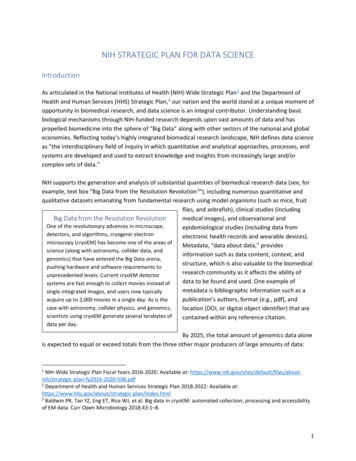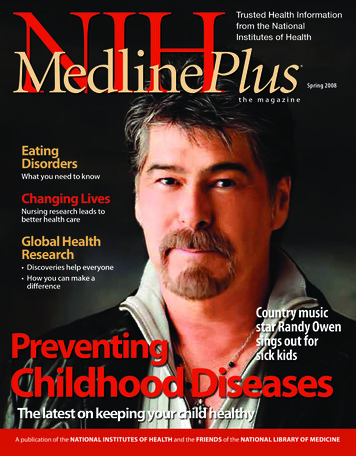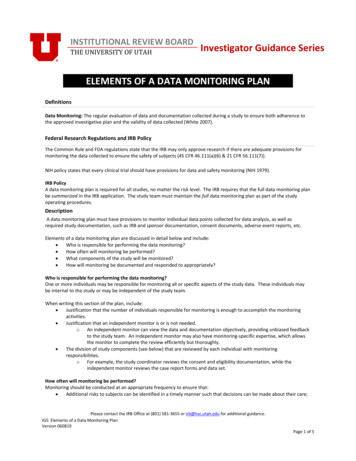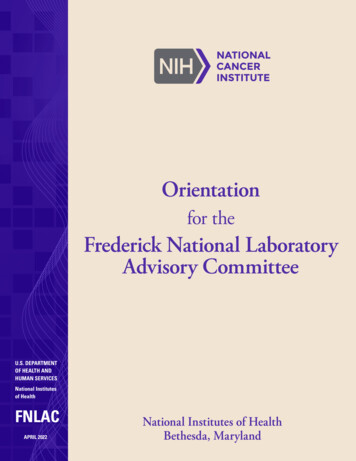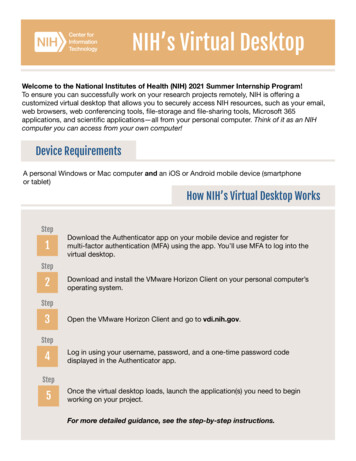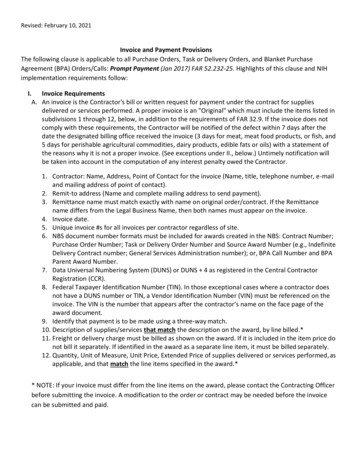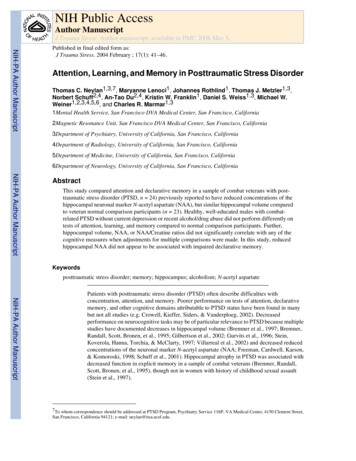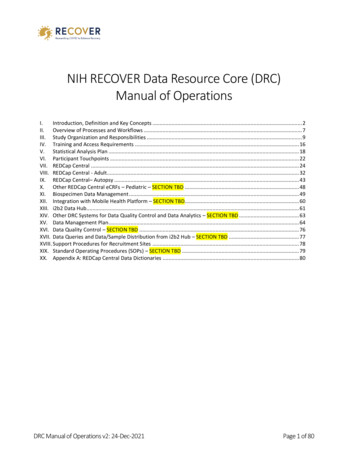
Transcription
NIH RECOVER Data Resource Core (DRC)Manual of OperationsI.Introduction, Definition and Key Concepts . 2II. Overview of Processes and Workflows . 7III. Study Organization and Responsibilities . 9IV. Training and Access Requirements . 16V. Statistical Analysis Plan . 18VI. Participant Touchpoints . 22VII. REDCap Central . 24VIII. REDCap Central - Adult . 32IX. REDCap Central– Autopsy . 43X. Other REDCap Central eCRFs – Pediatric – SECTION TBD . 48XI. Biospecimen Data Management . 49XII. Integration with Mobile Health Platform – SECTION TBD. 60XIII. i2b2 Data Hub. 61XIV. Other DRC Systems for Data Quality Control and Data Analytics – SECTION TBD . 63XV. Data Management Plan . 64XVI. Data Quality Control – SECTION TBD . 76XVII. Data Queries and Data/Sample Distribution from i2b2 Hub – SECTION TBD . 77XVIII. Support Procedures for Recruitment Sites . 78XIX. Standard Operating Procedures (SOPs) – SECTION TBD . 79XX. Appendix A: REDCap Central Data Dictionaries . 80DRC Manual of Operations v2: 24-Dec-2021Page 1 of 80
I.Introduction, Definition and Key ConceptsA. IntroductionThe purpose of the Manual of Operations (MOO) is to describe the operations of the Data Resource Core(DRC). The MOO describes roles and responsibilities of DRC personnel and teams, touchpoints with theAdministrative Coordinating Core (ACC), Clinical Science Core (CSC), and Biorepository Core (PBC). It alsodescribes processes and workflows associated with integration of the DRC with other components of theconsortium. It includes data management plans describing the processes, procedures, tools, and roles andresponsibilities with respect to data management.The scope includes all data collected from adult, pediatric, and autopsy cohort studies for which consentwill be obtained. Data flow from screening visit, consent and enrollment, data collection and curation andextraction to the DRC i2b2 Research Hub is covered in this document.B. Document -21V3Planned 28Jan-22DescriptionFirst draft required for submission to Mass General Brigham IRB to obtain cededreview. Includes some gaps that are not required for obtaining reliance agreementand will be fleshed out prior to MoO v1 release.Reflects operations as they are defined on 12-Nov-21, which corresponds to AdultBeta REDCap Central in the HMS FPI environment. There are still gaps in thisdocument in regard to some of the DRC’s operations, specifically as these relate todata quality control and monitoring activities, the autopsy and pediatric REDCaps, todata transfers, and a few other key mechanisms. Gaps are indicated in yellowhighlight, and the MoO will be re-released on a regular basis.Reflects operations as they are defined on 22-Dec-21, which corresponds to AdultREDCap Central in the MVP environment and imminent launch of Autopsy REDCapCentral in the MVP environment. There remain significant gaps in the definition ofrequirements as they relate to the Pediatric cohort and data transfer requirementsare still being defined.C. Key Concepts and AbbreviationsAdministrative Coordinating Center, RTI International (ACC) – Provide oversight and monitoring support inaddition to communication, work group, protocol development, and implementation support.Adverse Event (AE) – Any symptom, sign, illness or experience that develops or worsens in severity duringthe course of the study (excluding endpoints determined to be due to SARS-CoV-2 infection, section Error! Reference source not found.). Intercurrent injuries should be regarded as adverse events. Abnormal resultsof research procedures are considered to be adverse events if the abnormality: results in study withdrawal;is associated with a serious adverse event; is associated with clinical signs or symptoms; leads to additionaltreatment or to further diagnostic tests; is considered by the investigator to be of clinical significance.DRC Manual of Operations v2: 24-Dec-2021Page 2 of 80
Application Programming Interface (API) – A software intermediary that allows two applications orsystems to talk to each other. APIs are the mechanism whereby data are transferred from one system toanother system or processing commands (remote procedure calls) are executed among systems.Authorization to Operate (ATO) - the official management decision given by a senior organizational officialto authorize operation of an information system and to explicitly accept the risk to organizationaloperations (including mission, functions, image, or reputation), organizational assets, individuals, otherorganizations, and the Nation based on the implementation of an agreed-upon set of security controls.Biorepository Core, Mayo Clinic - Receive, manage, and make available to researchers a diverse range ofbiospecimens obtained from RECOVER research studies.Case Report Form (CRF) – A printed, optical, or electronic (eCRF) document designed to capture allprotocol-required information for a study.Clinical Research or Study Coordinator (CRC) – An individual that handles the administrative and day-to-dayresponsibilities of a clinical trial. This person may collect or review data before it is entered in the studydatabase.Clinical Science Core (CSC) – A group organized to coordinate and build the RECOVER research consortium.The RECOVER CSC is based out of NYU Langone. The CSC is responsible for coordinating data and samplecollection within the consortium, and developing methods for monitoring protocols, including recruitment,data quality, and safety measures to identify adverse events. The CSC guides communication andengagement efforts with key stakeholders, including patients and healthcare providers.Data Resource Core (DRC) – A group organized to coordinate and build data management processes on theRECOVER study. The DRC is responsible for data collection, data transfers and harmonization (includingbiospecimen data), and data analysis. The RECOVER DRC is based out of Mass General Brigham.Electronic Data Capture (EDC) – The computerized collection and management of clinical trial data forpatients and participants. On this program, the EDC in place to capture data is REDCap, an open-sourceelectronic data capture tool developed at Vanderbilt University that is in wide use at academic centersacross the world.Electronic Health Record (EHR) – A digital version of a patient’s paper chart. EHRs are real-time, patientcentered records that make information available instantly and securely to authorized users.Extract Transform and Load (ETL) – A data integration process that extracts data from one or multiple datasources into a single, consistent database (that follows a consistent data model, or format) that is loadedinto a data warehouse or target system.Good Clinical Practice (GCP) – A standard for the design, conduct, performance, monitoring, auditing,recording, analyses, and reporting of clinical trials that provides assurance that the data and reportedresults are credible and accurate, and that the rights, integrity, and confidentiality of trial participants areprotected.DRC Manual of Operations v2: 24-Dec-2021Page 3 of 80
Federal Information Security Modernization Act (FISMA) – FISMA describes the federal government’scybersecurity practices. modernization-actHealth Insurance Portability and Accountability Act (HIPAA) Privacy Rule – The first comprehensiveFederal protection for the privacy of personal health information. The Privacy Rule regulates the waycertain health care groups, organizations, or businesses, called covered entities under the Rule, handle theindividually identifiable health information known as protected health information (PHI).Informatics for Integrating Biology & the Bedside (i2b2) – A self-service cohort discovery tool that allowsusers to explore and query clinical data that has been de-identified and aggregated. I2b2 is open-sourcesoftware that was developed at Mass General Brigham and is in wide use at academic centers across theworld.Informed Consent Form (ICF) – A process by which a participant voluntarily confirms his or her willingnessto participate in a particular trial, after having been informed of all aspects of the trial that are relevant tothe participant’s decision to participate. Informed consent is documented by means of a written, signed,and dated informed consent form.Institutional Review Board (IRB)/Independent Ethics Committee (IEC) – An independent body constitutedof medical, scientific, and nonscientific members whose responsibility is to ensure the protection of therights, safety, and well-being of human participants involved in a trial by, among other things, reviewing,approving, and providing continuing review of trials, protocols and amendments, and the methods andmaterial to be used in obtaining and documenting informed consent of the trial participant.Manual of Operations (MoO) and Manual of Procedures (MOP) – The MoO is a description of theprocesses, procedures, services and information related to data management, including data collection,data transfers, data transformation and harmonization, and data transformation. A MoO is developed toensure data integrity across a clinical trial. A MOP translates the protocol into a set of operationalprocedures to guide study conduct. A MOP is developed to facilitate consistency in protocolimplementation and data collection across study participants and clinical sites. There is some overlapbetween the MoO and the MOP. Essentially, the MoO focuses on tactical procedures for data managementwhile the MOP focuses on study procedures, compliance and safety.National Institutes of Health (NIH) – the government entity that is funding this clinical trial via the NationalHeart, Lung, and Blood Institute (NHLBI).Observational Study Monitoring Board (OSMB) – A group of individuals independent of the studyinvestigators that is appointed by the NIH to monitor and ensure the safety of participants and the validityof data in NIH-supported or conducted clinical trials.Office for Human Research Protection (OHRP) – A federal government agency within the Department ofHealth and Human Services (DHHS) charged with the protection of human participants participating ingovernment-supported research. The OHRP issues assurances to institutions reviewing human participantsresearch and oversees compliance of regulatory guidelines by research institutions.DRC Manual of Operations v2: 24-Dec-2021Page 4 of 80
Package Insert – A compilation of the clinical and nonclinical data on the investigational product(s) that isrelevant to the study of the investigational product(s) in human subjects.PASC Biorepository Core (PBC) – The Biobank where all participant biospecimens are sent for processing,storage, and distribution. The RECOVER PBC is based at Mayo Clinic.Principal Investigator (PI) – The individual with primary responsibility for achieving the technical success ofthe project, while also complying with the financial and administrative policies and regulations associatedwith the award. Although Principal Investigators may have administrative staff to assist them with themanagement of project funds, the ultimate responsibility for the management of the sponsored researchaward rests with the Principal Investigator.Protected Health Information (PHI) – A subset of individually identifiable health information, oral orrecorded, relating to a participant’s past, present, or future physical or mental health or condition (e.g.,medical or research record). The institutional review board (IRB) or Privacy Board may determine what isconsidered PHI; however, in general, PHI includes health information that is linked to identifiers of theindividual or of relatives, employers, or household members of the individual. Some common identifiers ofhealth information include names, social security numbers, addresses, and birth dates, among others.Personal Identifiable Information (PII) - Any representation of information that permits the identity of anindividual to whom the information applies to be reasonably inferred by either direct or indirect means.Quality Control (QC) – The internal operational techniques and activities undertaken within the qualityassurance system to verify that the requirements for quality of trial related activities have been fulfilled(e.g., data and form checks, monitoring by study staff, routine reports, correction actions, etc.)RECOVER – Researching COVID to Enhance Recovery, https://www.recovercovid.org/, the name of theproject that is building a nationwide study population to support research on the long-term effects ofCOVID-19.Serious Adverse Event (SAE) – Adverse events are classified as serious or non-serious. A serious adverseevent is any AE that is: fatal; life-threatening; requires or prolongs hospital stay; results in persistent orsignificant disability or incapacity; a congenital anomaly or birth defect; an important medical event.Standard Operating Procedure (SOPs) – Detailed written instructions to achieve uniformity of theperformance of a specific function across studies and patients at an individual site.Statistical Analysis Plan (SAP) – A document containing a detailed description of the principal features ofthe analysis described in a clinical trial protocol, and which includes procedures for statistical analysis ofprogrammatic variables.D. How to Use this DocumentThe MoO serves as a reference and handbook that details the study’s operations as these relate to datamanagement. Its purpose is to provide the operational detail to ensure that data management proceduresare carried out consistently across the program. The MoO is intended to serve as a study guide thatDRC Manual of Operations v2: 24-Dec-2021Page 5 of 80
facilitates adherence to study procedures as these relate to data collection, data transfers, data deidentification, data integrity, data security, and data distribution.The DRC Team (investigators, coordinators, statisticians, etc.) develop the MoO before the study cancommence and keep it updated throughout the study to record and implement amendments to theprotocol and to document refinement of procedures.The MoO is a dynamic document that will be updated throughout the conduct of the study to reflect anyprotocol or consent amendments and any changes to core systems and data procedures. The MoO ismaintained in a format that allows it to be easily updated and is part of the site-specific IRB approval forceded review at Mass General Brigham.DRC Manual of Operations v2: 24-Dec-2021Page 6 of 80
II.Overview of Processes and WorkflowsRECOVER study data may be divided into two broad categories: Structured and unstructured. Structureddata can be simple (e.g., surveys/lab tests) or complex (e.g., sleep studies). The Research Electronic DataCapture tool (REDCap), an open-source data capture tool developed at Vanderbilt University, can be usedto collect many types of structured and simple data. When more complex data such as polysomnography,imaging, mobile health, genomic and immunoassay results are generated, i2b2 becomes a more effectiveoption, not just to collect these more complex data, but also to harmonize all the different data types andmake them available later for researchers in the form of integrated, multi-dimensional data downloads viaan i2b2-based investigator workbench. In summary, REDCap is a tool for data capture, while i2b2 is a toolthat enables interoperability and delivery of complex (and big) data that can be used to answer researchquestions about post-acute sequelae of SARS-CoV-2 infection (PASC).The RECOVER clinical consortium consists of 33 primary clinic sites (hub sites) with over 200 clinic subsites.Each site is responsible for screening, recruitment, consent, clinical procedures, and data collection. Thehub sites are responsible for management and governance of sub-sites, but each site will enter data directlyinto a REDCap instance called REDCap Central. REDCap Central is a FISMA-compliant REDCap instancehosted in cloud infrastructures by Harvard Medical School (HMS) Amazon Web Services (AWS). Informationis collected both by clinical research coordinators (CRCs) at the clinic sites and by study participants (orcaregivers) using REDCap remote survey instruments.The Data Resource Core (DRC) manages the process of ingesting and managing REDCap data from theprimary clinic sites into REDCap Central. In REDCap Central, each site inputs data in a secure REDCapelectronic case report form (eCRF). The DRC is responsible for managing the REDCap data, which includesperforming quality control/quality assurance (QC/QA) checks in an iterative manner and mapping thecommon data elements (CDEs) into a data ontology (detailed data dictionary). When that process iscomplete, the data are promoted from REDCap Central to the i2b2 Data Hub, also housed in FISMAmoderate cloud infrastructures. Data will persist in REDCap Central even once it is promoted to the i2b2environment. Once in i2b2, the data can be linked to other data sources and queried for aggregate countsby consortium investigators with requisite site-related human studies training.As PASC appears to affect every organ system in the body, the requirements for data collection forRECOVER are quite broad. Thus, NIH has charged the DRC not only with capturing the voluminousstructured data that will be generated by the prospective observational cohort studies, but also the morecomplex data associated with participant health records, large electronic health record (EHR) databases,digital/mobile health devices, and the like. The i2b2 Data Hub is where this disparate data is collected andserves to facilitate the collection, annotation, harmonization, curation, and sharing of clinical datagenerated by RECOVER, including but not limited to, clinical observations, lab result data, demographics,social determinants of health, pathology data, imaging data, mobile health data, genomic and other –omicsdata for the RECOVER Consortium.Importantly, the DRC also is charged with making these data interoperable and available for subsequentanalyses via investigator workbenches. This requirement can only be achieved if the clinic sites agree towork closely with the DRC to implement procedures for de-identifying, linking, harmonizing, and ensuringthe quality of the data they generate while conducting their observational studies.DRC Manual of Operations v2: 24-Dec-2021Page 7 of 80
Additional EHR data may be collected via large consortia, such as National COVID Cohort Collaborative(N3C), and transferred to the i2b2 Data Hub.E. Functional WorkflowThe RECOVER program studies the long-term effects of SARS-CoV-2 based on the study of several cohorts:Pediatric, Adult, Autopsy, and Pregnancy/Pediatric. Several REDCap Central projects are set up to capturedata for each of these cohorts. Data relating to the adult cohort is captured in Adult REDCap Central, datarelating to the autopsy cohort is captured in Autopsy REDcap Central, and data relating to the pediatriccohort is captured in several REDCap instances. In addition, data relating to the mothers who are part ofthe Pregnancy cohort is entered into Adult REDCap Central and data relating to their infants is captured inone of the Pediatric REDCap Centrals. In all cases, study participants are consented, samples are collected,and data is captured in REDCap Central.Data is entered into REDCap Central via two mechanisms: 1) direct entry into REDCap Central by CRCs atthe clinic sites and 2) entry of data into surveys by participants in the study (and, in the case of the Pediatriccohort, their caregivers). The data is validated for quality using SAS and R within the FISMA envelope thathosts REDCap Central and then flows into a central i2b2 database (“i2b2 Data Hub”) for analysis. The data ismade available to investigators via a front-end built into the i2b2 Data Hub.It is also possible that data from the electronic health record (EHR) will be extracted, transformed andtransferred to the DRC. Some plans are under way with N3C, which has already collected EHR data forCOVID cohorts. Per this plan, in case some of the participants enrolled into RECOVER have also provideddata to N3C, then EHR currently stored in N3C data warehouses for those specific RECOVER participants willbe transferred to the DRC.DRC Manual of Operations v2: 24-Dec-2021Page 8 of 80
Figure 1 Functional Scope DiagramIII.Study Organization and ResponsibilitiesThe study organization, staff roster, roles, and responsibilities are described in this section. Members of theDRC are identified along with their roles and responsibilities. In addition, an organizational chart providesan overview of the structure of the study and the relationships among the staff members.A. Data Resource CoreThe DRC is charged with the following programmatic activities: Creating and maintaining REDCap Central, an electronic data capture (EDC) tool to manage theentry of data by staff at clinic sites and by participants as well as order entry of meta dataassociated with biospecimen collection. The DRC team is responsible for building the electroniccase report forms (eCRFs) that are described in the adult, pediatric and autopsy protocols. Creating and maintaining a scalable, configurable, and integrated, cloud-based central data hubusing i2b2, called the i2b2 Data Hub. Leveraging the i2b2 Data Hub to ensure fidelity of the data and to harmonize data captured acrossthe RECOVER program and make this data available. Implementing procedures to manage data across all the entities involved in RECOVER. This includesmanaging de-identification of data and linkage using Universal Unique Identifiers (UUIDs). Performing data quality control (QC) checks on the data collected in REDCap Central.DRC Manual of Operations v2: 24-Dec-2021Page 9 of 80
Producing the statistical analyses for the cohorts that are required for study design and fordownstream analysis of the data captured in this study.Enabling analytic functions through the implementation of analysis tools that are integrated withthe i2b2 Data Hub.Distributing data to CSC, ACC, PBC per programmatic requirements.Integrating data from various data sources per programmatic requirements.DRC Key PersonnelNameAndreaFoulkesContact ard.eduNatalie Boutinnboutin@partners.orgVivian Gainervgainer@partners.orgJames eethai@mgh.harvard.eduDRC Manual of Operations v2: 24-Dec-2021Role and ResponsibilitiesMPI Contact PI Leads protocol design and statistical analysis plans Coordinates management of DRC Leads eCRF development and implementationMPI Leads i2b2 Data Hub Leads integration with HMS and AWS/FISMA moderateenvironment for eCRFs Leads integration of data from PBC, MHP and other platforms MPI Leads operational planning and implementation of study protocols Contributes to study design and statistical analysis Contributes to eCRF development and implementation Contributes to i2b2 Data Hub Lead – Sample Management and Program Management Leads program management for the DRC Ensures quality of deliverables and operational excellence Responsible for managing protocols and SOPsLead – i2b2 Data Hub Leads development of i2b2 Data Hub. Responsible for quality of i2b2 Data Hub, including data qualityand integrity. Provides program management for activities relating to i2b2 DataHubLead – REDCap Central management, Support, and Data QualityControl Leads development of REDCap Central Responsible for quality of REDCap central, including ease of use,data quality and integrity. Provides program management support for activities relating toi2b2 Data Hub.Lead – Biostatistics Leads Statistal Analysis Plans Contributes to communications with the OSMB Provides statistical analysesPage 10 of 80
The DRC has established a sub-award with HMS to provide the FISMA-compliant cloud-based infrastructurefor REDCap Central. The role of HMS on the study is to provide softwares necessary for the execution of theRECOVER goals and manage a secure IT cloud computing platform and information technology services onbehalf of the DRC in support of the RECOVER program, secured at the FISMA Moderate level, as authorizedby NHLBI.NameDoug MacFaddenWilliam BarnettPaul WilliamsJoe ZurbaContact Informationdouglas aul Williams@hms.harvard.eduJoe Zurba@hms.harvard.eduRole and ResponsibilitiesMPICo-I and IT Services LeadIT Services Technical LeadIT Services Security Lead and Security ManagerB. Clinical Science Core (CSC)The CSC is responsible for building the RECOVER research consortium, harmonizing and coordinating dataand sample collection within the consortium, and developing methods for monitoring protocols, includingrecruitment, data quality, and safety measures to identify adverse events. The CSC is responsible forsubcontracting with all RECOVER cohort hubs. The CSC also guides communication and engagement effortswith key stakeholders, including patients and healthcare providers. The DRC will collaborate with the CSC toreview study protocols, write statistical analysis plans, design eCRFs, and develop training materials.NameStuart KatzLeora HorwitzAndrea TroxelFrancesca PrattCarol ChangMeelee TomContact eelee.tom@nyulangone.orgRole and ResponsibilitiesMPI – focus on Pediatric cohortMPI – focus on Adult cohortMPI – focus on Autopsy cohortSr. Project ManagerSr. Project ManagerSr. Project ManagerC. Administrative Coordinating Center (ACC)The ACC is responsible for oversight and monitoring of the entire RECOVER initiative, which includes datadashboards and monitoring. The DRC will transfer enrollment data to the ACC and the ACC will generatereports based on this data. RTI International, an independent nonprofit research institute, was awardedfunding to serve as the ACC and brings expertise from their work functioning as the ACC for the CONNECTSnetwork.NameNedra WhiteheadLisa NewmanSarah HatcherTonya FarrisKate BurdekinSean HanlonDemian PasquarelliContact ti.orgdpasquarelli@rti.orgDRC Manual of Operations v2: 24-Dec-2021Role and ResponsibilitiesPrincipal Investigator (PI)Project Director (PD)Committee Support and Monitoring/ Oversight co-leadCommittee Support and Monitoring/ Oversight co-leadInformatics co-lead, SharePoint list point of contactInformatics co-lead, web portal point of contactInformatics supportPage 11 of 80
JoNita CoxAlexandra Bornkesseljcox@rti.orgabornkessel@rti.orgProject ManagerCommunications Task LeadD. Biorepository Core (PBC)The PBC, which is based out of the Mayo Clinic Biorepository, is responsible for receiving and managing allthe RECOVER samples. Scope of work includes providing clinic sites with kits to collect sample, managingtransport of samples from clinic sites to the PBC Central Facility in Minnesota, processing and storingsamples, and distributing samples.NameMine ÇiçekStephen ThibodeauThomas FlotteJordan WeyerHeba AbsehContact a@mayo.eduRole and ResponsibilitiesMPIMPIMPI – focus on autopsyProgram ManagerEducation SpecialistE. Study SitesThe roles and responsibilities of the investigators and study sites may include: Maintenance of study binder Participation in protocol finalization and preparation of study materials Compliance with protocol, MOP, MoO, IRB, Federal and state regulations Membership in a Steering Committee and other committees Rec
procedures to guide study conduct. A MOP is developed to facilitate consistency in protocol implementation and data collection across study participants and clinical sites. There is some overlap between the MoO and the MOP. Essentially, the MoO focuses on tactical procedures for data management

